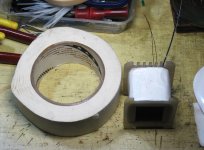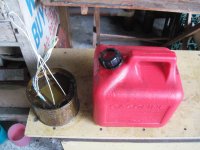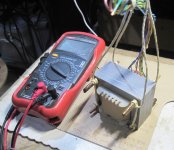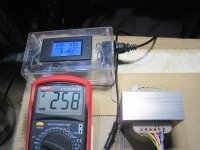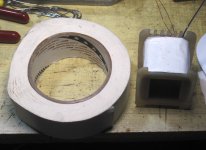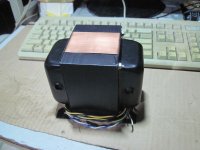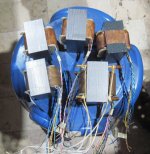Tony what about this machine?
990723A Hand Dual Number winding machine Winder Guitar Coil UK VAT | eBay
990723A Hand Dual Number winding machine Winder Guitar Coil UK VAT | eBay
Tony what about this machine?
990723A Hand Dual Number winding machine Winder Guitar Coil UK VAT | eBay
yes, that is my workhorse machine.....
transformer for tube amp....Nomex paper tapes were used and copper strip eletctro static sheilds.....
idle current is 0.02 mA and 1.8 watts idling loss using an H18 core, 0.35 mm thickness.....
core is 1 1/8 inch center leg stacked to 40 mm..soaking fully submerged in varnish for 30 minutes and then hang out to dry...
idle current is 0.02 mA and 1.8 watts idling loss using an H18 core, 0.35 mm thickness.....
core is 1 1/8 inch center leg stacked to 40 mm..soaking fully submerged in varnish for 30 minutes and then hang out to dry...
Attachments
traffo for tube power amp using tv scanning pentodes.....6LQ6/6JE6....B+ pf 500 volts at 400 mA and grid bias supply of -100 volts available...core is 1 1/2 stacked to 60mm using golden mars surplus cores, idles at 4.8 watts and 40 mA...0.3 mm copper belly banding...
Attachments
tony,
do you wind your output transformers strictly in accordance with Pat Turner's designs .. in terms of his secondary layers and how he sort of *breaks each layer up* into sections with different numbers of turns in each section and then joins turns in different secondary layers so he can get his 2/4/8/16 ohm windings etc ?
Or do you decide to provide a basic 4 or 8 ohm tapping and leave it at that ?
Some of his designs are quite complicated.
Reason I ask is I have downloaded a copy of Ruben Lee's book [1955 edition] and he has a drawing of a push pull transformer using a c-core on page 164 and it would be virtually impossible to apply pat turner's designs to such a core, he probably states somewhere anyway that his designs only apply to laminated cores.
do you wind your output transformers strictly in accordance with Pat Turner's designs .. in terms of his secondary layers and how he sort of *breaks each layer up* into sections with different numbers of turns in each section and then joins turns in different secondary layers so he can get his 2/4/8/16 ohm windings etc ?
Or do you decide to provide a basic 4 or 8 ohm tapping and leave it at that ?
Some of his designs are quite complicated.
Reason I ask is I have downloaded a copy of Ruben Lee's book [1955 edition] and he has a drawing of a push pull transformer using a c-core on page 164 and it would be virtually impossible to apply pat turner's designs to such a core, he probably states somewhere anyway that his designs only apply to laminated cores.
Reason I ask is I have downloaded a copy of Ruben Lee's book [1955 edition] and he has a drawing of a push pull transformer using a c-core on page 164 and it would be virtually impossible to apply pat turner's designs to such a core, he probably states somewhere anyway that his designs only apply to laminated cores.
You should take a better look at Pat Turner's website 🙄🙄
i use a 4 section primary and 3 section secondary,
the total primary turns are broken into 4 equal coils,
section 1 and 4 are series connected, and sections 2 and 3 seriesed together.
the three secondary sections have 4, 8, and 16 ohms in single layers
i am quite happy with these arrangements...
stacking the cores, i divide the cores into three equal groups...
i use 0.35mm cores for OPT's...
i find this practice good enough for my taste,
i have no access to C cores yet so i can not comment...
BudP, YvesM, cerrem are members here who do OPT's,
Patrick Turner is one heck of an excellent practitioner, i learned a lot from these masters...
Patrick Turner welcomes emails...
i hate complicated designs and avoid them, simple is just as good...
but otoh, what seems to be complicated at first sight may not be that complicated at all once you get to build it....
we can give you all the details, but you still have to make one on your own, and that is where the magic is at.....trust me....
the total primary turns are broken into 4 equal coils,
section 1 and 4 are series connected, and sections 2 and 3 seriesed together.
the three secondary sections have 4, 8, and 16 ohms in single layers
i am quite happy with these arrangements...
stacking the cores, i divide the cores into three equal groups...
i use 0.35mm cores for OPT's...
i find this practice good enough for my taste,
i have no access to C cores yet so i can not comment...
BudP, YvesM, cerrem are members here who do OPT's,
Patrick Turner is one heck of an excellent practitioner, i learned a lot from these masters...
Patrick Turner welcomes emails...
i hate complicated designs and avoid them, simple is just as good...
but otoh, what seems to be complicated at first sight may not be that complicated at all once you get to build it....
we can give you all the details, but you still have to make one on your own, and that is where the magic is at.....trust me....
there is a video on youtube of a guy using one, although his set up looks odd and a bit shaky.:
YouTube
...and no layer insulation 😱😱😱!
...and no attempt to fill the winding window completely 😱😱😱!
...and have a look at this open variac 😱😱😱😱😱!
Best regards!
Last edited:
I am not sure why anyone would even bother to wind a power transformer at home, at least here *in the west*.
An isolation transformer step up or down from 220/230 to 400/440 volts will surely do the trick as long as you watch current capacity.
Properly varnished and factory construction. Some are even potted .. albeit in plastic.
You can get a 400 VA transformer for less than 50 euros from tme.eu.
An isolation transformer step up or down from 220/230 to 400/440 volts will surely do the trick as long as you watch current capacity.
Properly varnished and factory construction. Some are even potted .. albeit in plastic.
You can get a 400 VA transformer for less than 50 euros from tme.eu.
do it and learn.....
it is easy to criticize other people's work....
even easier to make your own traffos....
the McIntosh 275 opt used c cores, no inter layer winding insulation, no insulation between coils, made with just one size wire, all scrambled winding...
i see nothing out of the ordinary here:
it is easy to criticize other people's work....
even easier to make your own traffos....
the McIntosh 275 opt used c cores, no inter layer winding insulation, no insulation between coils, made with just one size wire, all scrambled winding...
i see nothing out of the ordinary here:
Attachments
picked up one of those winders off e-bay, it looks pretty small, maybe they sent me the *junior winder*.
its about 7 inches tall and 11 inches across the shaft, is that roughly the same as your original winder ? how do I provide tension in the wires ?
its about 7 inches tall and 11 inches across the shaft, is that roughly the same as your original winder ? how do I provide tension in the wires ?
tony,
when you are taking your leads from inside the transformers is this the stuff you are
using or do you use the heatshrink plastic/pvc stuff ?
Polyurethan glass sleeve F class - GP 25 type
when you are taking your leads from inside the transformers is this the stuff you are
using or do you use the heatshrink plastic/pvc stuff ?
Polyurethan glass sleeve F class - GP 25 type
- Home
- Amplifiers
- Power Supplies
- Tony's latest traffo DIY build
